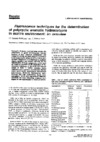Identificador persistente para citar o vincular este elemento:
https://accedacris.ulpgc.es/handle/10553/1092
| Campo DC | Valor | idioma |
|---|---|---|
| dc.contributor.author | Santana-Rodríguez, José Juan | en_US |
| dc.contributor.author | Padrón Sanz, Carolina | en_US |
| dc.date.accessioned | 2009-10-08T02:31:00Z | - |
| dc.date.accessioned | 2018-03-01T13:46:21Z | - |
| dc.date.available | 2018-03-01T13:46:21Z | - |
| dc.date.issued | 2000 | en_US |
| dc.identifier.issn | 0365-4877 | en_US |
| dc.identifier.other | 856 | - |
| dc.identifier.uri | https://accedacris.ulpgc.es/handle/10553/1092 | - |
| dc.description.abstract | Polycyclic Aromatic Hydrocarbons (PAHs) arecompounds of great environmental interestbecause of their potential carcinogenic andmutagenic activity and their frequent occurrencein the environment, above all in the marine envi-ronment. Therefore it is an important to establishsimple, sensitive and reliable methods for thedetermination of these compounds. In this workwe report an overview on the application of flu-orescence techniques to the study and determi-nation of PAHs in marine samples: water,sediments and organisms. Conventional fluores-cence spectroscopy, synchronous fluorescencespectroscopy, Shpol ́skii fluorescence spec-troscopy and high performance liquid chro-matography (HPLC) with fluorescence detectionconstitute the most interesting analytical tech-niques for the determination of these pollutants. | - |
| dc.language | eng | en_US |
| dc.publisher | 0365-4877 | - |
| dc.relation.ispartof | Analusis | en_US |
| dc.source | Analusis [ISSN 0365-4877]. v. 28 (8), p. 710-717 | en_US |
| dc.subject | 2301 química analítica | - |
| dc.subject.other | Espectroscopia de fluorescencia | - |
| dc.subject.other | Compuestos aromáticos policíclicos | - |
| dc.title | Fluorescence techniques for the determination of polycyclic aromatic hydrocarbons in marine environment: an overview | en_US |
| dc.type | info:eu-repo/semantics/review | en_US |
| dc.type | Article | en_US |
| dc.identifier.doi | 10.1051/analusis:2000280710 | en_US |
| dc.identifier.scopus | 0034503215 | - |
| dc.identifier.isi | 000166552600008 | |
| dc.contributor.authorscopusid | 56248783900 | - |
| dc.contributor.authorscopusid | 6508056917 | - |
| dc.identifier.absysnet | 212966 | - |
| dc.identifier.crisid | 2051 | - |
| dc.description.lastpage | 717 | - |
| dc.description.firstpage | 710 | - |
| dc.relation.volume | 28 | - |
| dc.investigacion | Ciencias | - |
| dc.rights.accessrights | info:eu-repo/semantics/openAccess | - |
| dc.type2 | Reseña | en_US |
| dc.contributor.daisngid | 30342984 | |
| dc.contributor.daisngid | 7326534 | |
| dc.identifier.external | 2051 | - |
| dc.identifier.external | 2051 | - |
| dc.contributor.wosstandard | WOS:Rodriguez, JJS | |
| dc.contributor.wosstandard | WOS:Sanz, CP | |
| dc.date.coverdate | Diciembre 2000 | |
| dc.identifier.ulpgc | Sí | es |
| dc.description.jcr | 0,675 | |
| dc.description.jcrq | Q4 | |
| item.fulltext | Con texto completo | - |
| item.grantfulltext | open | - |
| crisitem.author.dept | GIR Energía, Corrosión, Residuos y Agua | - |
| crisitem.author.dept | Departamento de Ingeniería de Procesos | - |
| crisitem.author.dept | GIR IUNAT: Análisis Químico Medioambiental | - |
| crisitem.author.dept | IU de Estudios Ambientales y Recursos Naturales | - |
| crisitem.author.dept | Departamento de Química | - |
| crisitem.author.orcid | 0000-0002-3030-2195 | - |
| crisitem.author.orcid | 0000-0002-5635-7215 | - |
| crisitem.author.parentorg | Departamento de Ingeniería Electrónica y Automática | - |
| crisitem.author.parentorg | IU de Estudios Ambientales y Recursos Naturales | - |
| crisitem.author.fullName | Santana Rodríguez, Juan José | - |
| crisitem.author.fullName | Santana Rodríguez, José Juan | - |
| Colección: | Reseña | |
Citas SCOPUSTM
32
actualizado el 08-jun-2025
Citas de WEB OF SCIENCETM
Citations
29
actualizado el 25-feb-2024
Visitas
101
actualizado el 23-ene-2024
Descargas
370
actualizado el 23-ene-2024
Google ScholarTM
Verifica
Altmetric
Comparte
Exporta metadatos
Los elementos en ULPGC accedaCRIS están protegidos por derechos de autor con todos los derechos reservados, a menos que se indique lo contrario.
